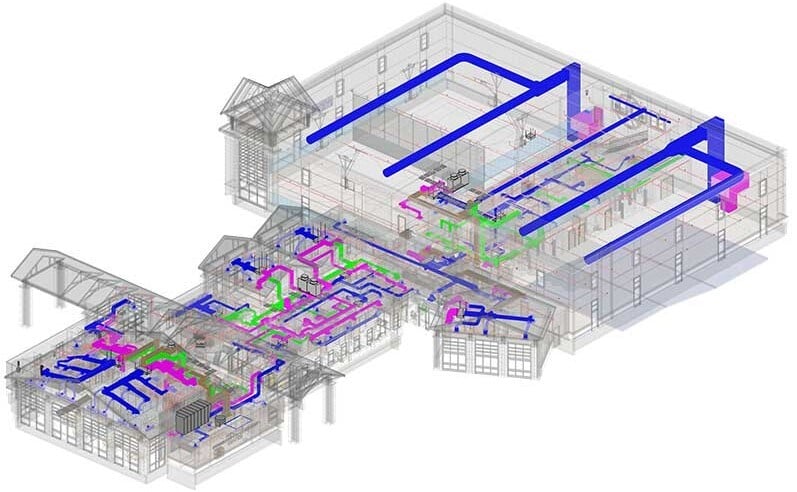
Ar. Ankit Pandey is a BIM Architect who completed his B.Arch from GGSIPU, New Delhi. He’s currently working with Novatr and has been involved with studios such as Studio Sustain & Arkance group (Previously Capricot technologies Pvt Ltd). His work reflects expertise in BIM software and automation tools. You can learn more about his work and connect with him on LinkedIn.
If you’re an architecture or engineering student stepping into 2026, you’ve probably heard the buzz around BIM. It’s no longer a fancy add-on skill; it’s what most top firms are demanding. For beginners, a BIM certification can be that extra push that helps you get noticed, land your first job faster, and start your career with confidence.
BIM is a technological convenience in the AEC industry that enhances pre-construction through budget analysis, clash detection, and error minimisation. It is the necessity for tomorrow, allowing the professionals of today and tomorrow to create smartly.
Some of the best BIM certifications are those that offer a mix of knowledge and hands-on practice.
Why Do Beginners Even Need BIM Certifications ?
Let’s be honest, a degree alone doesn’t guarantee a job anymore. Firms are looking for people who can contribute from day one, especially through digital workflows like BIM. A certification tells them that you’ve gone through structured training, you understand how the software and processes work, and you can collaborate effectively.
Growing demand for certified BIM professionals in the AEC industry
Across India and the world, the AEC industry is moving towards smarter, data-driven, and highly collaborative ways of working. Government initiatives, large infrastructure projects, and private developers are increasingly adopting BIM to cut down errors, speed up construction, and improve coordination among teams.
This shift has created a huge demand for BIM-skilled professionals, especially for those who are certified. Recruiters usually trust certified candidates more because it saves them training time. It signals that you already know the basics of BIM workflows, something that non-certified candidates often have to learn on the job. Firms don’t just want architects who know how to model; they want professionals who understand how BIM ties design, construction, and cost together. Certified candidates are often the first preference because they’re seen as ready to work on live projects from day one.
How certifications add credibility to early-career architects
For young architects starting, you can see how BIM certifications enhance career growth, acting as proof that you’ve invested time and effort in mastering something relevant. For a fresher with limited experience, it builds credibility instantly.
Having a BIM certification can make a noticeable difference. It shows employers that you’ve invested in your learning, understand how modern projects are delivered, and can collaborate effectively with Architects and consultants.
In a job market where hundreds of resumes look similar, a recognised certification helps you stand out. It’s a signal that you’ve gone beyond classroom learning and picked up a skill the industry actually values. More importantly, it builds your confidence to take on complex design coordination and documentation tasks early in your career.
-1.png?width=656&height=506&name=image%20(5)-1.png)
The Most Popular BIM Certifications and What Makes Them Worth It
There are metrics a learner should look at while choosing the right course for themselves. Think of three things, industry recognition, learning outcomes, and practical exposure. Don’t go for something that’s only about theory or software commands. Pick a course that actually helps you apply BIM concepts on projects.
Moreover, think of certifications that are valued, like those of Novatr’s BIM Professional Course for Architects, Autodesk, and BuildingSMART certifications. They’re accepted across companies and countries, making them a solid first step for beginners.
Here is an in-depth view of some of the best BIM certifications for beginners in 2025:
-
Novatr’s BIM Professional Course for Architects
Designed to make Architects industry-ready without disrupting their work schedules, Novatr’s BIM Certification offers an ideal balance of time investment and practical value. The program focuses on real-world MEP workflows, hands-on training, and global exposure that ensures you gain relevant BIM expertise that directly translates to better opportunities. Its online format and simulation-based learning path make it a cost-effective way to stay competitive in the evolving AEC industry.
-
Autodesk Certified Professional
The Autodesk Certified Professional credential is an industry-recognised BIM certification for validating technical proficiency in tools like Revit, AutoCAD, and Navisworks. While the certification process is relatively quick and affordable, it delivers strong returns by enhancing your credibility and employability.
-
BuildingSMART
BuildingSMART certifications focus on openBIM standards, ensuring professionals can collaborate seamlessly across disciplines and software platforms. Though the certification requires a more in-depth understanding of interoperability and data exchange, the investment in time and cost pays off in long-term career relevance
-
RICS BIM
Offered by the Royal Institution of Chartered Surveyors, the RICS BIM certification for architects and engineers emphasises strategic and managerial aspects of BIM implementation. While it may require a higher financial and time commitment compared to software-focused credentials, it provides unmatched credibility and leadership positioning in the construction and infrastructure sectors.
Common Mistakes Beginners Make While Choosing Certifications
-
Chasing certificates without real skill development
Many students and young professionals rush into getting “some certification” without understanding its relevance. A common mistake is chasing certificates for the sake of adding them to your resume, without really learning the skill behind them. Like doing multiple short courses with little real-world impact. Instead, focus on one strong certification that gives you a deep understanding and portfolio-worthy output.
-
Not checking the industry alignment of the program
Talk to professionals already working as BIM professionals. Ask what certifications actually helped them grow. Also, look for programs that include project-based learning and mentorship. That’s where the real value lies, as another leading issue is not checking whether the certification is aligned with the job roles they’re aiming for. What works for someone in the UK or the Middle East may not carry the same value in India
Also Read: 10 Award-Winning Architecture Thesis Projects From Around The World
Novatr’s Recommendation: The Ideal Beginner Path
If you’re just starting, the best approach is to follow a learning path that blends certification with hands-on project work and guidance from experts.
-
Start with Novatr’s BIM MEP Professional Program to build a strong foundation in both software proficiency and industry application. It not only helps you prepare for Autodesk certification but also trains you through real-world BIM projects. The program is designed to give you a gamified experience. It is also a beginner-friendly BIM program.
-
Consolidate your learning through projects and mentorship within Novatr’s ecosystem, bridging the gap between academic learning and real industry workflows, and ensuring you upskill with both skills and a BIM portfolio to prove them. By the end, you don’t just get a certificate, you have a portfolio and confidence to back it up.
-
Learn over 12+ software and plugins that matter in today’s AEC industry to stay a step ahead.
-
With triple certification from Autodesk, Novatr, and NSDC, you get industry-vetted validation.
-
A gamified platform to make upskilling fun and interactive.
Conclusion
Starting your journey as a Building Information Modelling professional might seem daunting, but it gets easier with the right process and foundation.
All it takes is the right guidance to build excellence, and that is where Novatr comes into play. With a tech-driven methodology, along with assignments and capstone projects, it builds just the right ground to be inspired and create your own tech-first models.
Reading about the future of BIM beyond Revit and Navisworks, and what you can expect from the ever-changing AEC industry, is one thing; acting upon it is a whole different story. Hence, if you wish to join the upskilling route, Novatr’s BIM Professional Course for Architects can be a good place to start. The beginner-friendly teaching methodology paired with industry-relevant tools makes it easier than ever to master BIM.
Was this content helpful to you







